Rediscovering Japan's Irori
A look at the form of the irori, its location in the house, its drawbacks and dangers, the social roles it reflected, and how it has survived.
Hi, I am Kjeld Duits and I created Old Photos of Japan.
Old Photos of Japan aims to be your personal museum for daily life in old Japan. I track down and acquire rare vintage prints and research and conserve them.
If you value or enjoy this work, please help support it:
PART 1 | PART 2 | PART 3 | PART 4 | PART 5 | PART 6 | APPENDIX
This is Part 2 of an essay about how people stayed warm in old Japan.
Illustrations of a Japanese irori (firepit) by American scholar Edward S. Morse (1838–1925). Published in Japanese Homes and Their Surroundings (1885).
The previous article introduced the irori, a chimneyless open firepit in the middle of the house. In this article we will dive a little deeper and look at the form of the irori, its location in the house, its drawbacks and dangers, the social roles it reflected, and how it has survived.
Place and Form
The irori’s location in the farm vividly illustrates its great importance. Since the Edo period (1603–1868) Japanese farms generally featured three basic spaces: an earthen floor entrance and work space known as doma (number 8 in the basic floor plan below), a living and dining room with a raised wooden floor known as hiroma (number 5), and tatami rooms for receiving guests (3) and sleeping (2).
The irori was almost always located in the center of the hiroma (6). Larger buildings could feature additional ones—for example in the zashiki (3) or the areas where silk worms were fed.

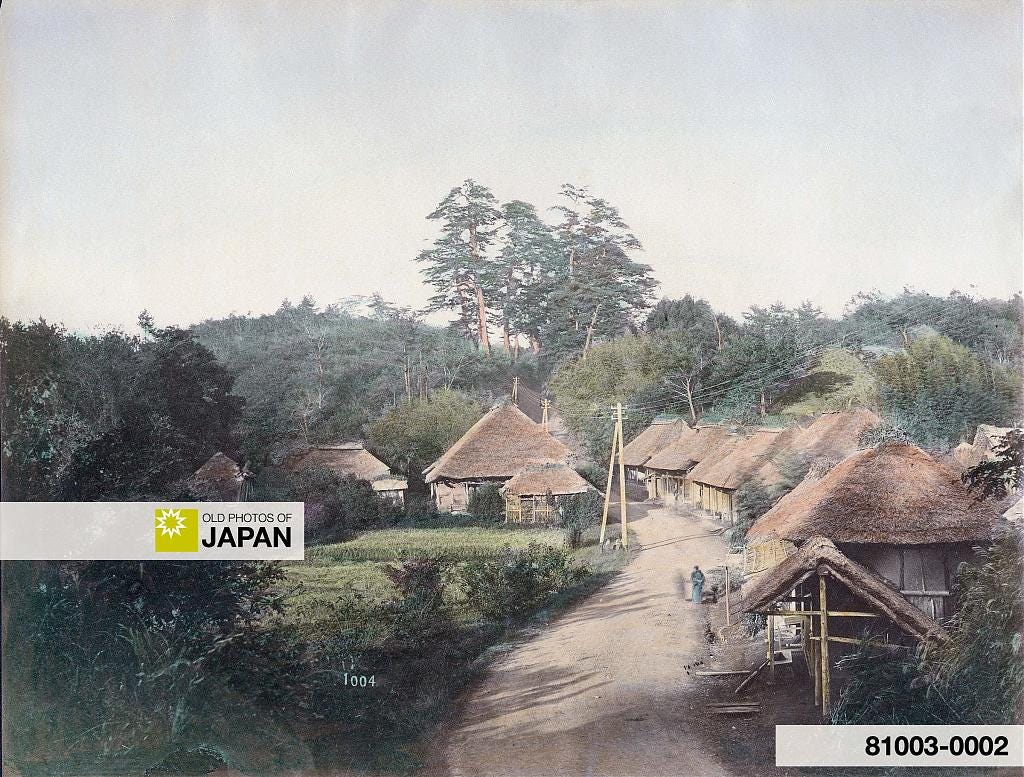
In its basic form an irori consisted of a square or rectangular opening in the floor with a broad wooden rim. Inside was a sunken stone-lined hearth for burning firewood, or occasionally charcoal.
Above the irori an adjustable bamboo pothook known as a jizaikagi (自在鉤) was suspended from the ceiling. This was used for hanging a pot or kettle over the fire. The height of this hook was adjusted with a lever (横木, yoyogi) which often featured a playful design such as a fish, hammer, or gourd.
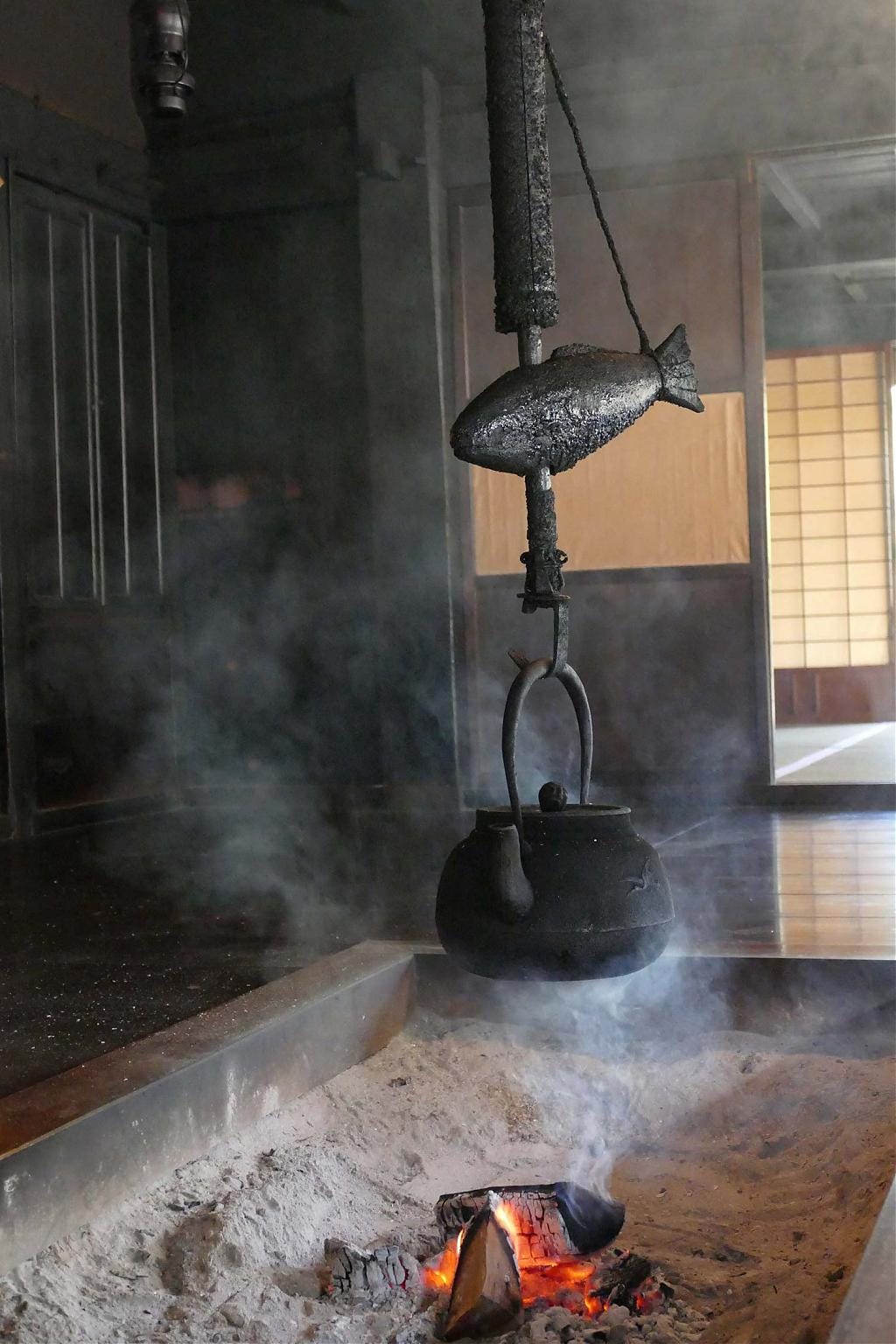
American scholar Edward S. Morse (1838–1925), who lived in Japan in the 1870s and 1880s, left us a contemporary description in his pioneering study of Japan’s architecture, Japanese Homes and Their Surroundings, printed in 1885 (Meiji 18):1
Fig. 174 gives a view of a common arrangement for the kitchen in the north of Japan, and in the country everywhere. Here the fireplace is in the centre of the room. A kettle is suspended over the fire by a chain, and other kettles are huddled around it to be heated. Overhead a rack hangs, from which fish and meat are suspended, and thus the smoke which ascends from the fire is utilized in curing them. Sometimes a large cushion of straw is suspended above the smoke, and little fish skewered with pointed sticks are thrust into this bunch of straw like pins in a pin-cushion.
In the front of fig. 175 a square copper box is noticed, having two round openings. This box is filled with water, which becomes heated by the fire, and is for the purpose of warming the sake, or wine. The tongs are stuck into the ashes in one corner. These consist of a long pair of iron chop-sticks held together at one end by a large ring, so that one leg of the tongs, so to speak, may not get misplaced. No inconsiderable skill is required to pick up hot coals with this kitchen implement, as in unaccustomed or awkward hands the ring prevents the points from coming together.
Japanese Homes and Their Surroundings (1895), 191–193
Drawbacks
Because the fire’s longevity mattered more than its strength, the most common fuel was firewood. This was also more readily available than precious charcoal. Often rice husks or ashes were sprinkled on the firewood to smother it and thereby make the fire last longer.
Firewood however produces a lot of smoke. There was no chimney or smoke pipe so the smoke filled the room and then slowly went up into the beams to escape through the vent holes at the ends of the roof.
This benefited the wooden structure. The warm air dried the wood thereby preventing rot, while the tar in the smoke made the beams and thatched roof insect resistant and waterproof. However, the smoke also caused problems.
One was eye disease. Another was soot. American anthropologist John B. Cornell (1921-1994) who studied village life in Okayama Prefecture from 1950 through 1951 mentioned in his research how the beams were caked with soot which “incessantly showers down.”2
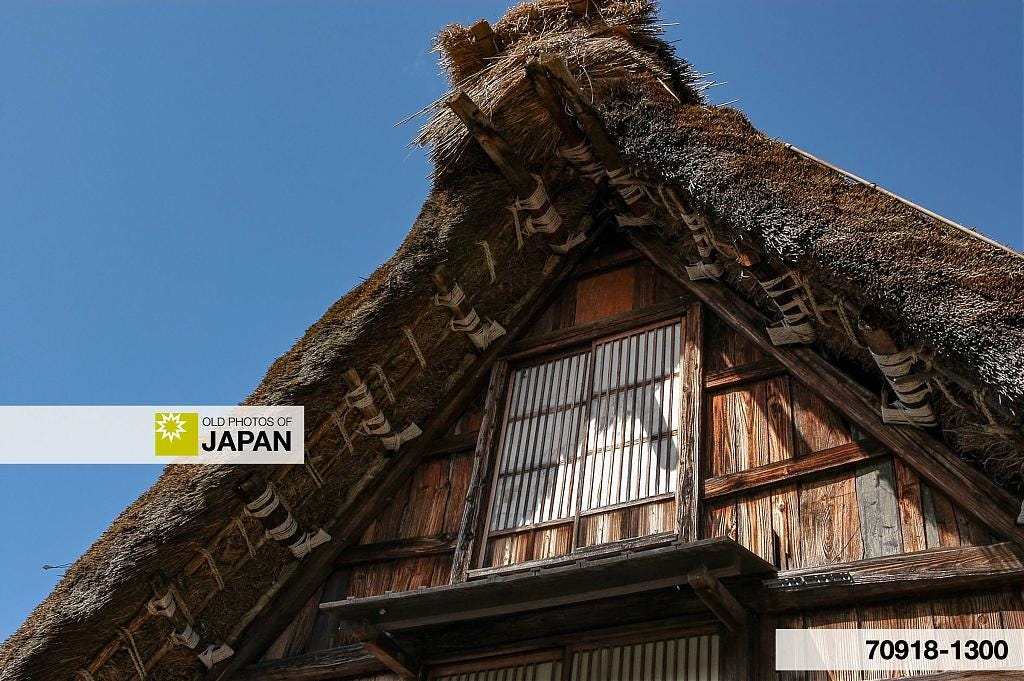
The irori had other problems. It was far from a perfect solution for heating in Japan’s northern mountain areas, which experience the highest snowfall in the world. This becomes especially clear from an episode told by English traveller and writer Isabella Bird (1831-1904), who in 1878 (Meiji 11) travelled through the backcountry of Japan. She describes a visit to an isolated mountain village in Niigata Prefecture. The torn paper of the shōji flaps in the wind which—having free rein—blows the irori’s ashes through the room.3
The climate is wet in summer and bitterly cold in winter. Even now it is comfortless enough for the people to come in wet, just to warm the tips of their fingers at the irori, stifled the while with the stinging smoke, while the damp wind flaps the torn paper of the windows about, and damp draughts sweep the ashes over the tatami until the house is hermetically sealed at night.
These people never know anything of what we regard as comfort, and in the long winter, when the wretched bridle-tracks are blocked by snow and the freezing wind blows strong, and the families huddle round the smoky fire by the doleful glimmer of the andon, without work, books, or play, to shiver through the long evenings in chilly dreariness, and herd together for warmth at night like animals, their condition must be as miserable as anything short of grinding poverty can make it.
Unbeaten Tracks in Japan (1888), 123
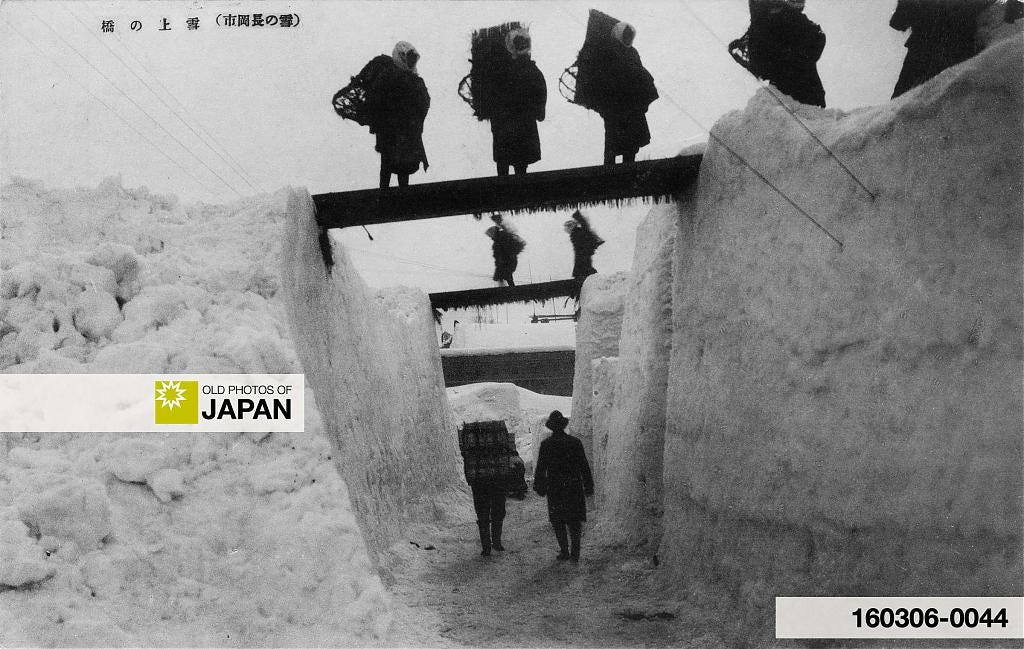
There was one more drawback. As an easily approachable hole in the floor the irori was a terrifying hazard for toddlers. One can imagine how they must have been drawn to the comforting warmth, dancing flames, and fascinating “playthings” like the iron chopsticks, kettles and other kitchenware, often screaming hot.
The history books are mostly silent about such accidents but they must have been common. Anthropologist Wiswell who studied village life in Kyushu during the mid-1930s actually mentioned such an accident:4
The other day I noticed Tsune’s hand. She cannot uncurl the middle finger. When she was a baby she grabbed an iron tong stuck in the fire-pit. The doctor grafted some skin from her arm, leaving an ugly scar, and put it on the palm of her hand, but did not straighten out the finger. Later on she had another nasty burn.
Ella Wiswell, The women of Suye Mura. (1982), 241
The irori was not the only danger. Wiswell also mentioned an “old lady who had let her granddaughter fall into the charcoal brazier. … Because of the burns all the back of her head is absolutely hairless.”5
Burns could be severe. Japanese bacteriologist Hideyo Noguchi (野口英世, 1876–1928), whose face has graced 1000-yen banknotes since 2004, fell into the irori as a child. A neighbor who came rushing in to help noted his injuries:6
The fingers of the left hand are mostly gone, and the left arm and the left foot and the right hand are burned, I know not how bad.
Gustav Eckstein, Noguchi (1931), 11
Noguchi’s disfigurement defined his life. As he would be unable to work as a farmer his mother focused on his education. He was inspired to become a doctor after a surgeon made his hand look better when he was a teenager.7
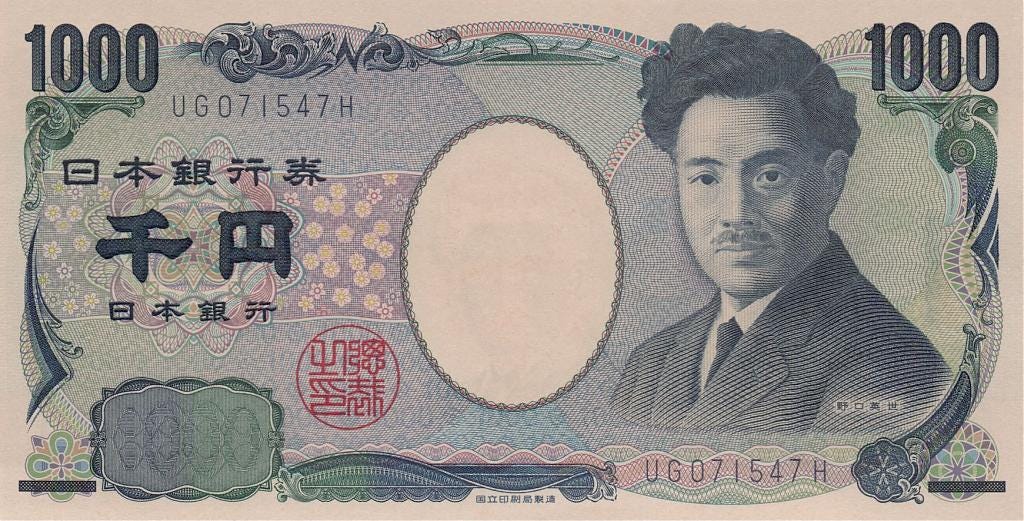
Keeper of the Fire
The irori revealed the makeup of a Japanese household. Each family member had a predetermined seating location based on family hierarchy. This reflected the accepted social order, but was also convenient for functionality. Young women sat close to the kitchen, while the head of the family sat close to the guest room.
His seat was sacrosanct. “Only a cat or a fool would sit in the master’s place” went one saying. A daughter-in-law could be sent back to her parents if she did so.8
When the son took over the role as head of the household he moved to the seat previously occupied by his father, while his wife received the spatula for ladling rice from his mother. “This custom was rigidly observed and was not quick to fall out of use,” according to celebrated Japanese folklorist Kunio Yanagida (柳田 國男, 1875–1962), who founded modern Japanese folklore studies.9
Generally the most subordinate member of the household was the wife of the eldest son, she was the first one to get up and the last one to sleep.10 It was her job to keep the fire “alive”. By doing this successfully she proved her reliability.11
As the first one to wake she started her day by kindling the fire. Her last duty before going to bed was burying burning embers in the ashes so that the fire would not completely go out. Until matches became common around 1882 (Meiji 15) this was one of her most important duties in the house.12 Later it often became her job to extinguish the fire before going to sleep.
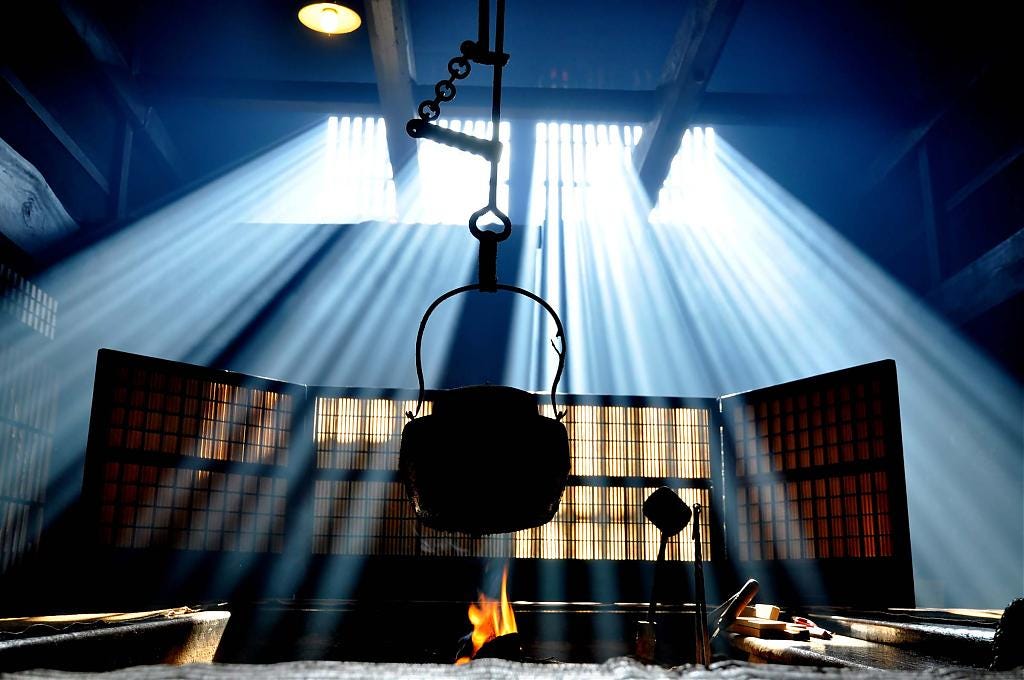
Irori Now
The irori remained an important part of rural life through the 1960s, but quickly vanished from daily life when electric, gas and kerosene heating offered more effective alternatives for heating.
Thankfully the irori is not gone. Seemingly racing towards extinction in the 1990s, it has been undergoing a cautious revival during the past few decades.
A growing number of restaurants, inns, and even some Airbnb locations have adopted the irori to attract customers. It has also been embraced by a number of residents of restored kominka (古民家, literally “old minka”).
While fire-places are still installed for heating in western-style homes, the irori has pretty much lost that purpose. People love the irori for its social aspects and it now functions mostly as an in-house barbecue or to create a nostalgic atmosphere.
Traditional Japanese inn Amami Onsen Nanten-en in rural Osaka has a small room with an irori in the lobby area specifically to create such an atmosphere. The irori is a relatively new feature—it was added in 1983 (Shōwa 58) though the pit itself dates back to the 1930s.
“It looks nice and appeals to the guests but I find it doesn’t give off a great deal of heat,” mentions staff member Gary Luscombe.
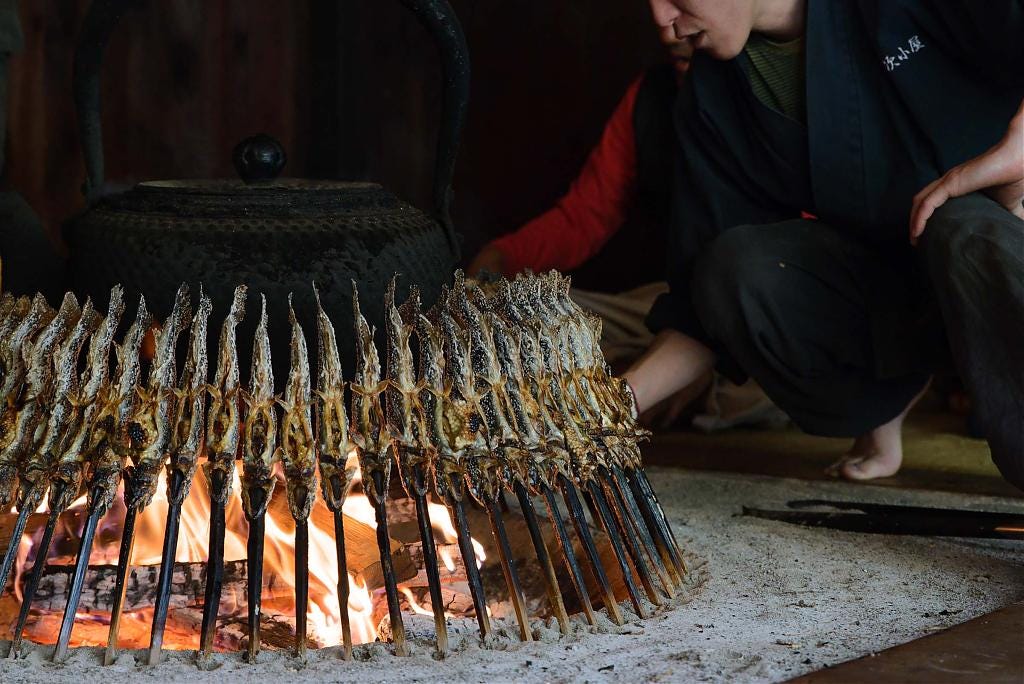
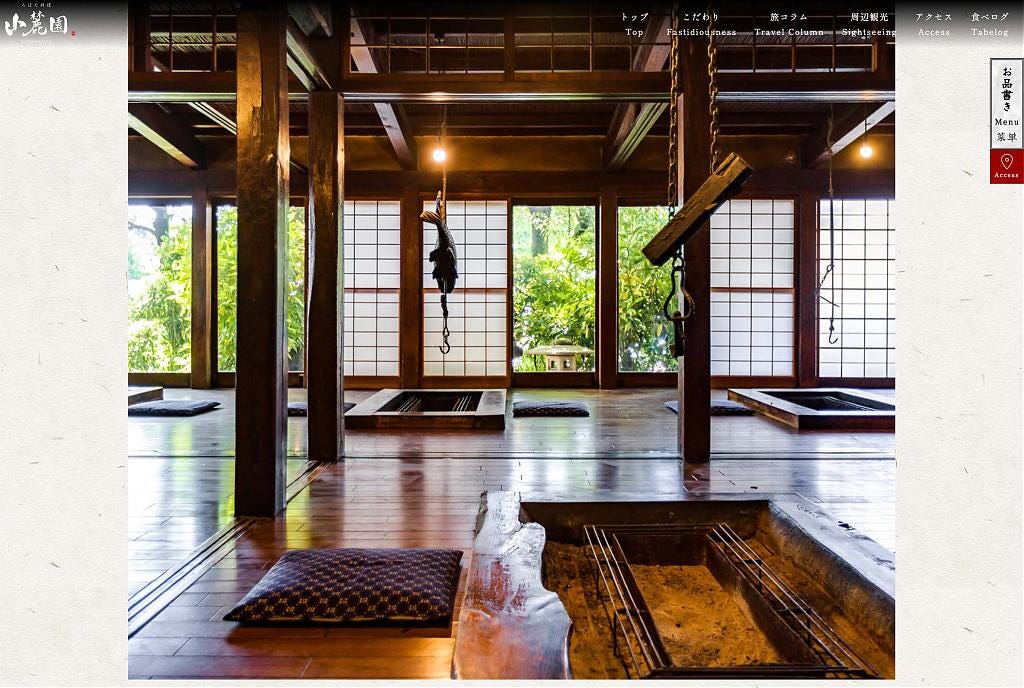
When it comes to heating kominka in the countryside, kerosene and wood stoves do a better job. Stuart Galbraith IV, founder of the popular Kominka Japan Facebook group, lives in a traditional home of over two centuries old. It used to have an irori. He explains why there is none now:
My minka had one but it was cemented over by the time I bought it, and in any case I opted for a wood stove since irori don’t generate much heat, and I really needed to heat my house in the winter!
Stuart Galbraith IV
Continue to Part 3 : Japan's Vanished Portable Fireplaces.
For more information about the top floor plan, continue to Minka Floor Plan.
SUPPORT OLD PHOTOS OF JAPAN
Help me research and save Japan’s visual heritage of everyday life.
Notes
Morse, Edward Sylvester (1895). Japanese Homes and Their Surroundings. New York: Harper & Brothers, 191–193.
Cornell, John B.; Smith, Robert J. (1956). Two Japanese Villages. New York, Greenwood Press, 165.
Bird, Isabella L. (1888). Unbeaten Tracks in Japan: an Account of Travels on Horseback in the Interior, Including Visits to the Aborigines of Yezo and the Shrine of Nikkō. London, John Murray, 123.
Smith, Robert J.; Wiswell, Ella Lury (1982). The women of Suye Mura. Chicago: University of Chicago Press, 241.
ibid, 257.
Eckstein, Gustav (1931). Noguchi. Harper & Brothers, 11.
ibid, 25–19.
Yanagida, Kunio, Terry, Charles S. (1969) Japanese Culture in the Meiji Era Vol.4: Manners And Customs. Tokyo: The Tokyo Bunko, 52.
ibid, 53.
Cornell, John B.; Smith, Robert J. (1956). Two Japanese Villages. New York, Greenwood Press, 162, 168–169.
In a sample schedule provided by Cornell the wife of the eldest son got up at 5:00 a.m. to kindle the fire in the irori and to start boiling rice. She went to bed at 10:00 p.m. after extinguishing the fire in the irori.
Petkova, Gergana (2021). Japanese Folktales and the Storytelling Tradition — Spatiotemporal Framework, Performance and Experience in Sprachlich-literarische “Aggregatzustände” im Japanischen: Europäische Japan-Diskurse 1998–2018. Berlin-Brandenburg: BeBra Wissenschaft, 129.
Yanagida, Kunio, Terry, Charles S. (1969) Japanese Culture in the Meiji Era Vol.4: Manners And Customs. Tokyo: The Tokyo Bunko, 52.


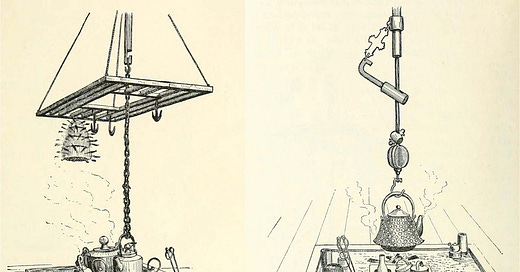



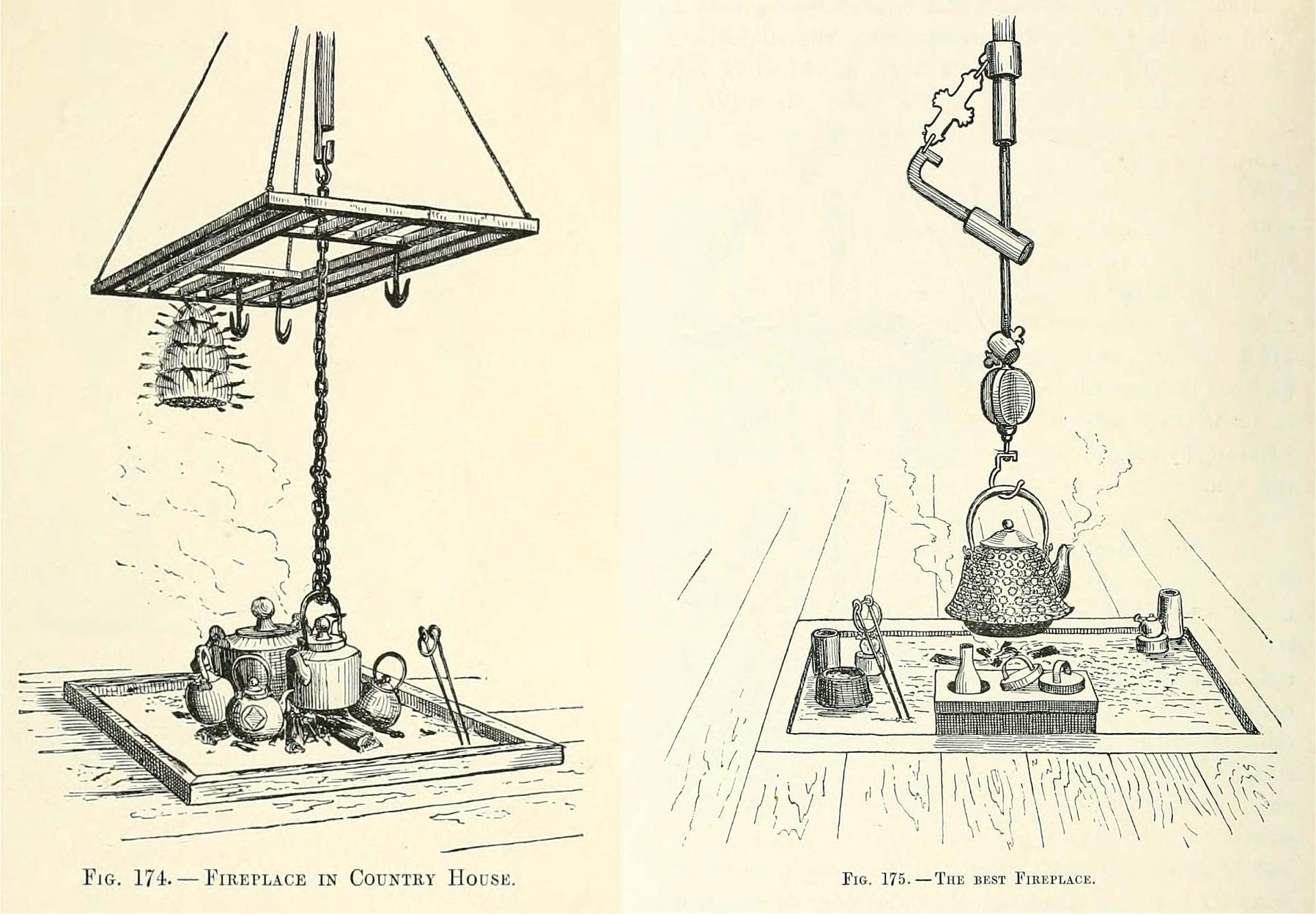
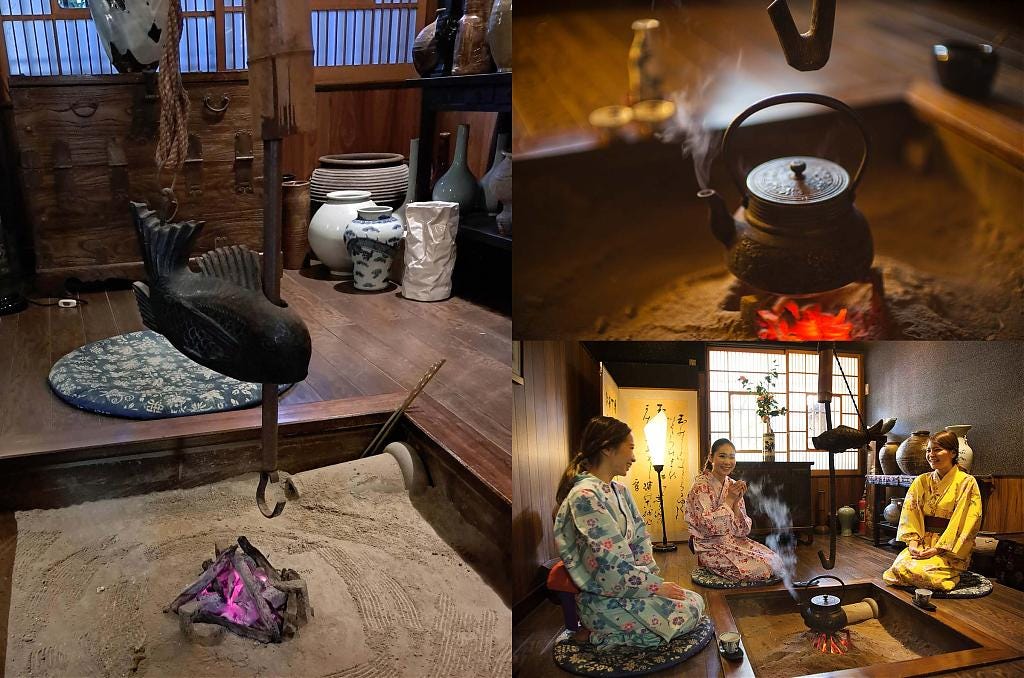
As charming as irori are, more modern home heating appliances must have been very welcomed in snowy northern winter regions. It’s hard to imagine how cold it must have been away from the irori! I sit here comfortably reading this and can only imagine the piercing cold suffered by poor families with nothing but layers of rags stitched together into yogi for keeping warm while sleeping on long cold winter nights. The celebration of any sign of spring was well earned!
The image of the grilling fish took me right back to this past June where we stumbled into the opening weekend of ayu season in Annaka where we were staying so I could participate in a sericulture workshop. It was summer though and no worries about keeping warm.